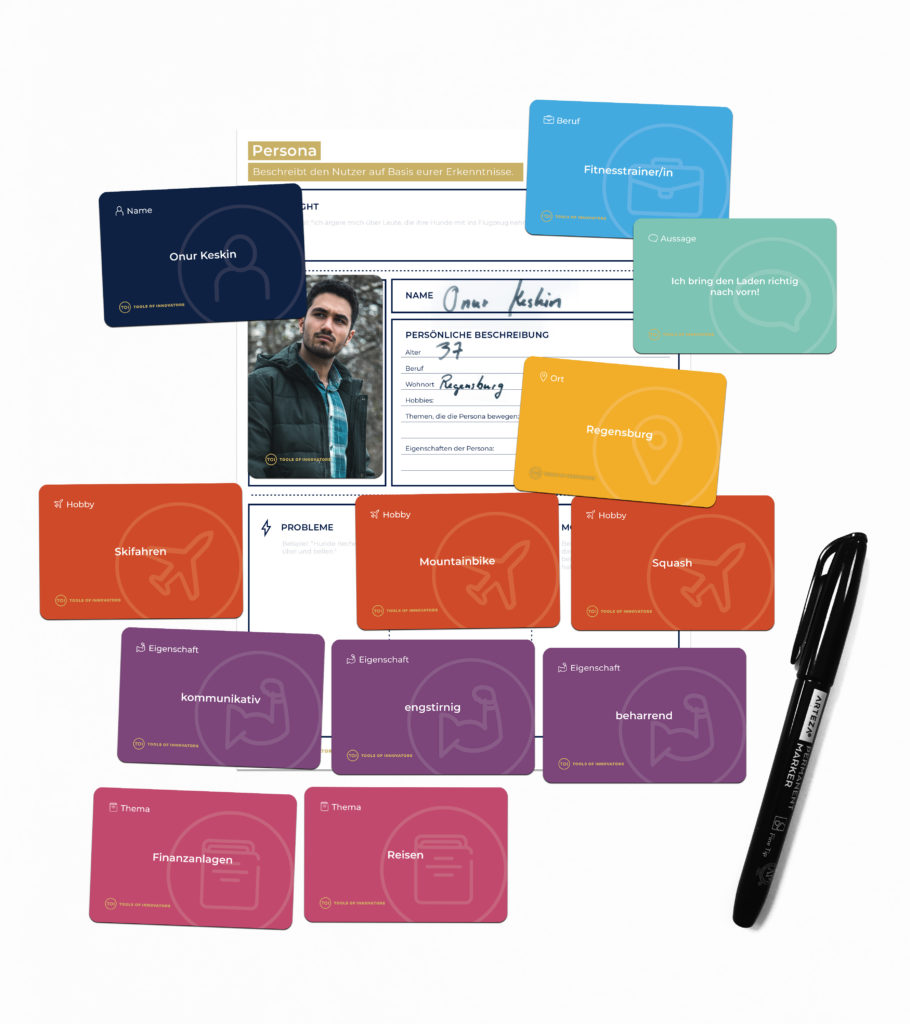In the past weeks we have been working extensively on the subject of personas, as we have developed a new tool. In the process we have looked at different types of Personas, possible applications and tips and tricks for the development and use of a Persona.

WHAT IS A PERSONA?
A persona is a hypothetical archetype of a potential customer. It represents a certain user type of the target group and has its characteristic requirements and behavior. In trainings we are often asked if the entire target group is represented by only one persona or if there may be several personas. Since it is an archetype, the persona should represent a group of people who are similar in their character characteristics, needs and behavior. But of course it is rarely possible to summarize the entire target group in only one type. Therefore one should look for differences and similarities in the target group and merge them into groups. After all, it would lose its purpose to represent each individual user by an individual persona. Personas are supposed to make our lives easier in the end.
Benefit
In product and service design, it is often difficult for us to distance ourselves from our own ideas and to consider the motivations and needs of the target group. Even reports and data from market research frequently do not provide much assistance in this regard, as they are often difficult to understand and impersonal. This is where personas come into the picture. In the design process they serve as a representation of the customer’s wishes and as a test for decisions: Would persona A take this step? Would persona B be discouraged if we integrated this function? Their liveliness in the form of interests, professions or quotations makes it easier for us to identify with you, to distance ourselves from our own needs and to keep a constant eye on the target group.
If you are interested in using personas in service design, I recommend the whitepaper series of our sister company Indeed.
DEVELOPMENT OF A PERSONA
Step 1 – Persona Structure: First of all the structure of the persona should be worked out, i.e: Which characteristics should be used to describe the target group? The structure can differ and should be adapted to the project.
Step 2 – Data collection: Afterwards the corresponding data has to be collected. Interviews, observations, shadowing and additional qualitative and quantitative research tools are used.
Step 3 – Data analysis: Now the data must be evaluated. The main goal is to identify patterns and to find out into which archetypes the target group can be subdivided. Each persona represents one of these archetypes.
Step 4 – A persona is created for each archetype. This includes the description of all characteristics that were defined at the beginning.
More tips, trends and examples can be found in our „Innovation Briefing“.
Tips & Tricks
- Stay focused: Always focus on the aspects that are really relevant in your context and for your project. Do not describe the persona by details that are not really of interest for your project.
- Limit yourself: Do not develop too many different personas. Try to represent your target group with about 3-7 personas. With this number your colleagues will be able to notice the characteristics and the personas will become real friends. This way you make sure that the personas are really used company wide.
- Preparation is key: Determine in advance by which characteristics you want to describe the target group and separate from characteristics that are irrelevant. In the work with our customers, this way new persona templates are always created, which we develop together with the customers and adapt to their context..
DIFFICULTIES AND CHALLENGES
In our experience, workshop participants often find it difficult to put themselves in the position of a target group on an ad hoc occasion and to describe them clearly and by specific characteristics. Often we as facilitators recognize ourselves in the personas of the different groups or learn that certain colleagues have been used as models. Unfortunately this does not lead to the goal.
The characteristics and descriptions are often very general, so that the personas do not vary from each other. This makes working with them more difficult and reduces their effect.
Our Persona Puzzle
From this experience we have designed the Persona Puzzle: A set of cards which gives the participants enough inspiration to design very specific and characteristic personas.

For each of these characteristics, the set gives 60 specifications from which the participants can choose. Of course these are only an incentive to become creative themselves. It was important to provide as much diversity as possible at this point so that we would not end up with Max Mustermann again. Therefore we have accepted that the card set now contains almost 500 cards.
In addition to these socio-demographic characteristics, the participants now only have to supplement each persona with project-specific content such as requirements, desires, problems and motivations.
This way, however, it is much easier to get started with the persona development – and the users can fully concentrate on the project-specific contents.


